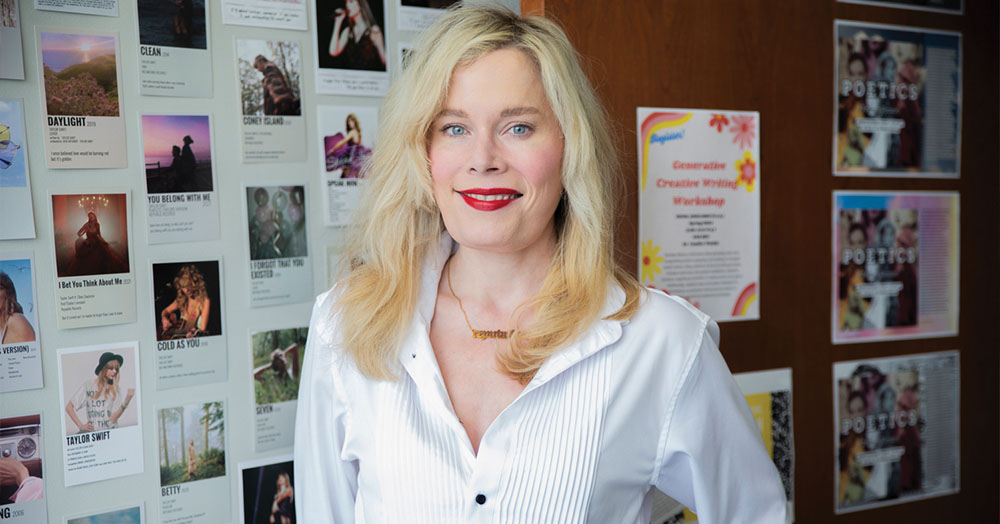Taylor Swift Course Takes Iowa Students Inside ‘The Tortured Poets Department’
 PHOTO: JOHN CHARLSON/THE DAILY IOWAN
Honors program instructor Candice Wuehle invites students to learn about poetry through the music of Taylor Swift.
PHOTO: JOHN CHARLSON/THE DAILY IOWAN
Honors program instructor Candice Wuehle invites students to learn about poetry through the music of Taylor Swift.
Whether or not you’re a fan, you know her. Her name regularly makes headlines, her face graces magazine covers, and her music fills coffee shops, shopping malls, and football stadiums.
Taylor Swift’s undeniable cultural impact begins with her chart-topping hits and Eras world tour, but University of Iowa honors program instructor Candice Wuehle (08BA, 14MFA) also credits the singer’s special relationship with her fans, her journey to re-record and reclaim copyright of her music, and her unprecedented power and visibility as a young woman.
The current “monoculture” around the megastar, as Wuehle describes it, is what inspired Wuehle to teach Poetics (Taylor’s Version), a UI honors course centered on Swift’s songwriting.
“There’s never been an artist like this in my lifetime, someone who—whether you like her or don’t—you have at least one strongly held opinion on her,” says Wuehle.
A poet herself and graduate of the esteemed Iowa Writers’ Workshop, Wuehle fused her love for poetry and Swift into the UI introductory and intermediate poetry course, which debuted this fall. The 22 honors students in the course explore different elements of poetry such as imagery, sound, and rhythm, which they practice by writing imitations of songs from Swift’s different eras. The class also discusses biographical criticism on topics such as gender, race, and trauma and memory in the context of Swift’s songwriting. As the students learn about these elements of poetry, they co-author The Taylor Swift Dictionary of Literary Terms, compiling definitions along with examples from Swift’s discography.
“She’s built this multiverse where she’s not just building chronologically on her work, but she’s commenting back to other albums.” —Candice Wuehle
What makes Swift’s lyricism such an ideal lens through which to learn about poetry?
“If you think of your average poet, they’re writing in one voice and genre for their whole career,” Wuehle says. But Swift is anything but average. From country pop to folk-inspired ballads to “almost kitschy melodramatic” songs like “But Daddy I Love Him,” Swift’s musical exploration knows no bounds, Wuehle says.
Swift not only defies musical genres, she also defies literary genres. In addition to albums like folklore, which explore the “more fictive” side of her storytelling, Swift has woven “herself as a character throughout her catalog,” according to Wuehle.
“She’s built this multiverse where she’s not just building chronologically on her work, but she’s commenting back to other albums,” she says. “The plot isn’t just progressing—it’s thickening.”
For example, Wuehle recalls being blown away when she realized Swift’s “my tears ricochet” from folklore pulls lyrics from Swift’s previous albums and combines them “to create this really cohesive chorus.”
On its last day, Dec. 13 (which also happens to be Swift’s birthday), the class will culminate in a “Swiftposium.” This public “Eras-style conference event” will include students’ presentations of their final papers, friendship bracelet-making, and possibly even a Taylor Swift impersonator, Wuehle says.
“I feel like Taylor Swift is so much about community that it’s really important to have some fun moments of community building throughout the semester,” she says.
As they move through the course, Swifties learn the elements of poetry and how to analyze it. But Wuehle also hopes students can use what they learn to “succinctly prove to their uncle at Thanksgiving who thinks Taylor Swift is just a pretty pop star” that Swift is a poet too—and a great one at that.
